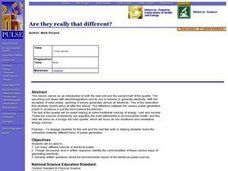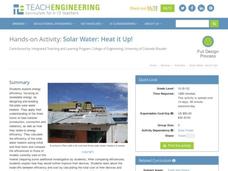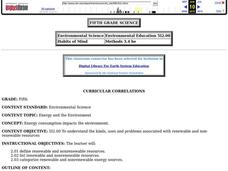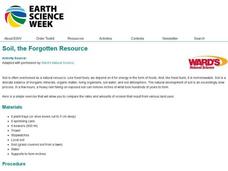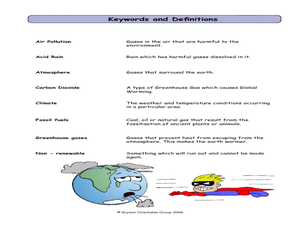Pennsylvania Department of Education
Wind and Water Wheels
Students identify wind and water as natural resources that create energy. In this natural resources and energy use lesson, students work in groups to construct a pinwheel, then explore the effects of wind and water on the pinwheel....
Curated OER
Science: Generating Electricity
Eighth graders examine the various methods of generating electricity and explain their commonalities. They determine what is the most common source of energy and what are the potential environmental health hazards due to electrical...
Curated OER
Green Team
Student explore the relationship of static electricity to current electricity, circuits, electromagnets, electro generators, and public electric utilities. In this Green Team lesson plan, 4th graders participate in hands-on science...
Curated OER
Life Unplugged
Students explore renewable and non-renewable energy sources, discuss how each source was created, and identify and sketch out the cycle of energy for each renewable source.
Dick Blick Art Materials
Matisse Prints du Soleil
The sun provides the link between this art and science activity. Kids use sunlight (or light from an artificial source) to produce heliographic prints on fabric or paper.
Curated OER
Sun Prints
Young scholars use coins to help them explore the sun as a source of renewable energy. They go outside in the sunshine and make a design by placing coins on their piece of black construction paper.
Teach Engineering
Solar Water: Heat it Up!
Young engineers are instructed to design and build their own solar water heaters. Then, they calculate the efficiency and cost and compare them to commercially available models. This is a full unit for pupils to apply their knowledge.
Curated OER
Energy and the Environment
Fifth graders define terms associated with renewable and nonrenewable resources. They identify materials that are renewable and nonrewable. They categorize a list into the correct type of resource.
Curated OER
Renewable vs. Non-Renewable Resources
Fifth graders, after brainstorming why conservation of resources is important, distinguish between renewable and non-renewable resources. They make a list of different types of natural resources on the board and then sort them into two...
Curated OER
Energy Dreams by Design
Students explore a new home and design some of its electrical features. They construct a model of the electrical features and consider accessibility for the handicapped into the room. In groups, students analyze the advantages and...
Curated OER
From Polymers to Bioplastics: Looking Toward Finding Renewable Resources
Students investigate the properties of polymers. For this chemistry lesson, students explain the importance of energy sources. They produce a bioplastic from the lab and evaluate its structural integrity.
Curated OER
Primary Activity: Dichotomous Key of Energy Sources
In this energy sources worksheet, students fill in a chart using a dichotomous key of energy sources. They use follow the directions and label items such as the sun, a windmill, and an oil rig with the proper number and letter labels...
Curated OER
Energy
For this energy worksheet, students complete a crossword puzzle by determining the terms associated with the 20 given clues. Students review alternative forms of energy in this worksheet.
Curated OER
TE Lesson: Using Heat from the Sun
Students examine fossil fuels, nuclear and renewable fuels. They study investigate types of heat transfer such as convection, conduction, and radiation. They complete crossword puzzles based on the vocabulary. They design, construct and...
Curated OER
Secret Message: Worksheet #1
In this following directions worksheet, students will have to follow 12 directions in order to decipher a secret message. The message is "Solar energy is renewable."
Curated OER
Lights Light Up My Life
Students conduct an investigation. In this energy conservation lesson, students observe and make predictions about fluorescent and incandescent light bulbs. Working in groups, students conduct an investigation to compare the two light...
Curated OER
Filling Up
In this filling up worksheet, students calculate the E85 per gasoline-gallon equivalent price to the E85 price per gallon to complete a chart of "alternative fuel". They use the data along with the price per gallon of gasoline to plot...
Curated OER
Soil, the Forgotten Resource
Students discuss soil understanding that is is often overlooked as a natural resource. In this science lesson, students recognize that we depend on it for energy in the form of foods. Students experiment with six boxes of soil to help in...
Curated OER
Watershed Landscape
Students demonstrate how water flows by building a human watershed using themselves. In this ecology instructional activity, students compare and contrast point-source and non-point source pollution. They write what they have learned...
Curated OER
Using Photovoltaic Cells and Systems
This interesting document suggests nine different activities for shedding light on photovoltaic cells. A bit of background information is furnished for you, as well as many, many resource links. Listed for each activity are a learning...
Curated OER
Biomass: Potato Power
Students put together a potato battery that powers a digital clock. In this potato battery lesson plan, students learn the connection between energy from biomass and how we can apply it.
Curated OER
Climate Chaos Week
Pupils research the pros and cons of wind farm technology as an alternative source of energy. The class is divided into two groups that should formulate a debate on each side of the argument. Groups use a debate guide to help develop...
Curated OER
Make a Windmill
Students explore Earth science by conducting an energy experiment in class. In this windmill lesson, students identify how wind has been used to pump water throughout history and the latest developments wind energy has produced. Students...
Curated OER
Mission 5: Energy and the Environment
In these energy and environment worksheets, students learn about energy sources and the role they have with the environment. Students complete an 18 page packet for the activity.



